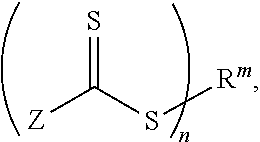Pseudothermoplastic, self-crosslinking composites
a technology of thermoplastics and composites, applied in the field of thermoplastics and self-crosslinking composites, can solve the problems of toxicity of isocyanates used, toxicity of epoxy systems and curing agent components used there, and process labor, etc., and achieve the effect of reducing the toxicity of epoxy systems and curing agent components
- Summary
- Abstract
- Description
- Claims
- Application Information
AI Technical Summary
Benefits of technology
Problems solved by technology
Method used
Image
Examples
example
General Procedure for Producing Prepregs and Laminates
[0107]The production of the laminates is effected in a heatable hydraulic press. They are built up layerwise from prepregs, with at most between 9 to 15 prepregs being compressed into one ca. 2 mm thick laminate.
[0108]As reinforcing material for the fiber composite materials produced in this work, a standard fabric from WELA is used, which is marketed under the trade number 7628. This fabric has a weight per unit area of 202 g / m2 and for better further processing is provided with a size finish and a finish named TF 970 not explained in more detail. The finish provides in general for good fiber-matrix adhesion, in that it enters into the development of covalent bonding between matrix and fabric.
[0109]For the production of the prepregs, a ca. 55 wt. % acetone solution consisting of the Diels-Alder educts will be produced, so that they are mixed together in molar equivalent to the DA-functional groups. In this context, Diels-Alder e...
PUM
| Property | Measurement | Unit |
|---|---|---|
| crosslinking temperature T1 | aaaaa | aaaaa |
| crosslinking temperature T1 | aaaaa | aaaaa |
| crosslinking temperature T1 | aaaaa | aaaaa |
Abstract
Description
Claims
Application Information
 Login to View More
Login to View More - R&D
- Intellectual Property
- Life Sciences
- Materials
- Tech Scout
- Unparalleled Data Quality
- Higher Quality Content
- 60% Fewer Hallucinations
Browse by: Latest US Patents, China's latest patents, Technical Efficacy Thesaurus, Application Domain, Technology Topic, Popular Technical Reports.
© 2025 PatSnap. All rights reserved.Legal|Privacy policy|Modern Slavery Act Transparency Statement|Sitemap|About US| Contact US: help@patsnap.com



